Scale-up trials of foam-granulation technology — high shear
Pharmaceutical Technology Europe
The authors evaluate the scalability of foam-granulation technology using continuous foam addition in high-shear granulation equipment at the laboratory, pilot and manufacturing scales. Immediate- and controlled-release model formulations were used. Continuous and batch addition of foam were compared for the controlled-release model formulation at the manufacturing scale, and physical testing was performed on the granules and finished tablets.
In 1975, the first high-shear mixer granulator (the Gral granulator) was introduced to the pharmaceutical industry by GEA Collette NV (Belgium) and was recognized as a breakthrough in wet-granulation technology.1 Since then, the pharmaceutical industry has published and practised conventional methods to introduce liquid-binder systems to high-shear granulators by pouring, pumping and spraying. Those techniques have their own inherent issues such as ensuring even distribution of liquids throughout a moving powder bed during high-shear granulation.2,3 The concept of using foamed binders in pharmaceutical wet-granulation applications was initially published in 2004.4 The advantages of foamed-binder addition compared with conventional binder addition methods include the elimination of nozzles, improved process robustness in manufacturing, decreased water requirements, shorter drying times and reduces manufacturing time. These advantages result in a reduction in granulation manufacturing costs.
The scale-up of conventional wet-granulation processes involving solid dosage forms and the issues surrounding these activities have been documented in the pharmaceutical literature.5–10 In this study, an initial evaluation of the scalability of foam-granulation technology was conducted in high-shear granulation equipment at the laboratory (10 L), pilot (150 L) and manufacturing (600 L) scales. Immediate-release (IR) and controlled-release (CR) model formulations were used in the study. In addition, a comparison was made between continuous and batch addition of foam for the CR model formulation at the manufacturing scale. Laboratory-scale trials were conducted in the Larkin Laboratory at The Dow Chemical Company (Midland, MI, USA). Pilot- and manufacturing-scale trials were conducted at the Perrigo Company (Allegan, MI, USA). Granulation and processing variables were scaled linearly from laboratory to manufacturing scale. Testing conducted on each trial included physical testing of the prepared granules and finished tablets, as well as drug dissolution.
Experiment
Equipment. Laboratory-scale equipment included a 10-L, vertical high-shear granulator (model FM-VG-10; Glatt Air Techniques, Ramsey, NJ, USA) and a laboratory-scale foam generator (Corrosion Fluids Inc., Midland, MI, USA). Pilot-scale equipment included a 150-L, top-drive, high-shear granulator (model GMX-150; Vector Corp., Marion, IA, USA) and a laboratory-scale foam generator (Corrosion Fluids Inc.). Manufacturing-scale experiments used a 600-L Gral, top-drive high-shear granulator (GEA Niro Pharma Systems, Columbia, MD, USA) and a production-scale foam generator (model Top Mix type 100; Hansa Industrie-Mixer GmbH & Co., Stuhr-Heiligenrode, Germany).

Table 1 Protocol for IR and CR scale-up trials.
Table 1 lists the protocol used for the IR and CR scale-up trials. The variables were scaled linearly so that reasonable comparisons could be made. The maximum liquid flow rate that could be sustained using the Top Mix type 100 foam generator at the 600-L manufacturing scale was ~1.52 L/min of the 7% Methocel E5PLV binder solution. To maintain linear scaling, flow rates of 0.40 L/min at the 150-L pilot scale and 0.017 L/min at the 10-L laboratory scale were used. It should be noted that although the authors only had access to the type 100 foam generator, the Hansa Company has models that can deliver foamed liquids at much greater rates.
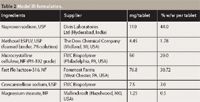
Table 2 Model IR formulation.
The model IR and CR formulations used in the scale-up trials are listed in Tables 2 and 3, respectively. Both formulations used a foamed 7% w/v Methocel E5PLV aqueous solution as the binder system.
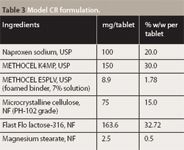
Table 3 Model CR formulation.
Granulation sequence (continuous method). Continuous foam addition was used for all three scales for both IR and CR formulations. Powders, except magnesium stearate (see Tables 2 and 3), were charged into the granulator (Figure 1) and mixed for 1 min at the laboratory scale and 5 min at the pilot and manufacturing scales to achieve a uniform mixture before the agglomeration step.
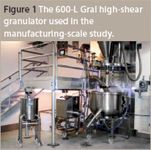
Figure 1
Foamed binder solution was incorporated at a continuous rate onto the moving powder beds in the high-shear granulators (Table 1). Figure 2 shows the equipment connection for the foam addition from the foam generator to the high-shear granulator at the manufacturing scale. Laboratory- and pilot-scale high-shear equipment is similar in configuration, only smaller.

Figure 2
After adding the foamed binder, the formulations in the laboratory-scale trials were mixed for an additional 30 s. The formulations in the pilot- and manufacturing-scale trials were mixed for an additional 5 min. This is common practice in the pharmaceutical industry when using conventional spray techniques and is called the wet-massing phase of a wet granulation. The purpose of the wet-massing phase is to distribute the liquid-binder system evenly throughout the powder mass. It is the authors' opinion, however, that when using foam technology, this step may be unnecessary because foam is capable of spreading among powder particles, and distributing much faster and more efficiently than conventional spray techniques.
After granulation, the formulations in the laboratory-scale trials were wet-milled using a CoMil (model 197; Quadro Inc., Millburn, NJ, USA). The pilot-scale trials used a CoMil model 196, and the manufacturing-scale trials used a CoMil model U30. All were equipped with a similar square-hole screen opening of 0.5-in and a square-edge impeller.
Granulation sequence (batch method). A batch-process trial was conducted on a CR formulation at manufacturing scale. Identical quantities of ingredients, including the foamed binder, were used as in the manufacturing-scale continuous trial so that direct comparisons could be made between the two processes. The only change was the addition of green food dye to the liquid-binder solution. The coloured solution allowed the authors to evaluate the powders after each wet-massing step by checking for areas of overwetting. Overwet areas theoretically would show up as dark green. The batch process allows wet granulations to be prepared by adding foamed binders to static powder beds. This innovation simplifies the wet-granulation process even further than the continuous foam addition process and may help reduce worker exposure to potent APIs.

Figure 3
Powders were added to the granulator and premixed in the same fashion as for the continuous process, then the mixer blades were turned off. Foam was pumped into the granulator on top of the static powder bed at a rate of 2 L/min. The inlet tube shown in Figure 2 was reconfigured so that the foam would be broadcast evenly across the surface of the static powder bed. Half of the quantity of the foam (19.3 kg) was added to the static powder bed. The granulator bowl was dropped so that a photograph could be taken (Figure 3). Then the bowl was raised, the mixer was turned on and the formulation was mixed for 5 min to distribute the foam. The mixer blades were then turned off and the remaining portion of the foam (19.0 kg) was pumped onto the static powder mass. The bowl was raised, the mixer was again turned on and the formulation was mixed for 5 min to fully incorporate the foam into the powders. Finally, the granulator bowl was dropped and the wet granulation was examined (Figure 4). In hindsight, after the completion of the batch-process trial, it was apparent that there had been enough headspace between the premixed powders and the interior of the granulator that the entire quantity (38.3 kg) of the foamed 7% Methocel E5PLV solution could have been pumped into the granulator initially.
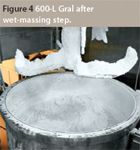
Figure 4
After wet-milling, the laboratory-scale granulations were dried in trays at 43 °C for 8–10 h. The pilot-scale granulations were dried in a Glatt model WSG-30 fluid-bed granulator–dryer. The manufacturing-scale granulations were dried in a Glatt model WSG-120 fluid-bed granulator–dryer (Figure 5). The drying parameters followed for the pilot- and manufacturing-scale trials were:
- Shaking interval: 60–90 s.
- Shaking time: 5–10 s.
- Inlet air dew point set point: 11–15 °C.
- Inlet air: 500–200 ft3/min.
- Inlet temperature setpoint: 55–75 °C.
- Endpoint outlet temperature: 35–38 °C.
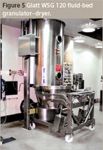
Figure 5
All granulations were dried to a moisture level of 3–6%. Moisture levels were determined with an IR-200 moisture analyser (Denver Instruments Co., Denver, CO, USA) operated at 105 °C. The dried granulations were sized using CoMil grater-type screens with the same size opening and impeller-tip speeds (laboratory scale: 2A062G037 screen, 1307 rpm; pilot and manufacturing scales: 2F062G037 screen, 500 rpm).
Tablet preparation. Tablets were prepared from the milled granulations on an instrumented 16-station Manesty Betapress (Thomas Engineering, Hoffman Estates, IL, USA) modified by Team Pharmaceuticals (Martin, MI, USA) and equipped with 7.14-mm, round, standard concave tooling for preparing the IR tablets and 10.3-mm, round, flat-faced, bevel-edged tooling for the preparation of the CR tablets. The tablet-press data acquisition and analysis system was from Binary Applications (Midland, MI, USA). Final compression forces of 8.9 kN and 26.7 kN were applied during tablet preparation. Target tablet weights of 250 mg and 500 mg were used for the IR and CR tablets, respectively.
Powder and granule testing. The milled granules were analysed for density, compressibility (Carr) index (CI), and particle-size distribution (PSD). The density of a 40-g sample of each granulation was tested with a tap-density tester (model 10700; VanKel Industries, Edison, NJ, USA). A volume measurement was taken before tapping (apparent density) and after 500 taps (tap density). The compressibility index was calculated as follows:

in which T is the tapped (packed) density (g/cm3) and B is the bulk (apparent) density (g/cm3).
A 40-g sample of each granulation was shaken for 5 min on a RoTap sieve shaker (model B; W.S. Tyler, Gastonia, NC, USA) equipped with a series of 11 screens and a pan. The amount of material retained on each screen size was measured and a PSD was calculated.
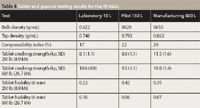
Table 4 Tablet and granule testing results for the IR trials.
Tablet-property testing. Tablets were tested for friability, thickness, crushing strength and drug dissolution. The friability of 20 randomly chosen tablets from each trial was measured by tumbling them for 6 min in a friabilator (Vanderkamp model 10801; VanKel Industries) and then measuring the percent weight loss. The crushing strength of 20 randomly chosen tablets from each trial was tested with a hardness tester (model HT500; Key International, Englishtown, NJ, USA). Tablet thickness was measured using a caliper (Absolute Digimatic, 500 series; Mitutoyo Corp., Japan) on 10 of the 20 randomly chosen tablets. The weight of each of the 20 tablets was measured and the percent weight variation was calculated.

Table 5 Tablet and granule testing results for the CR trials.
Dissolution testing of six individual tablets sampled from each of the trials was performed using a dissolution system (model VK7025; Varian, Cary, NC, USA). The method was as follows:
- Medium: de-ionized water, 900 mL, 37.5 °C.
- Apparatus 2: 50 rpm.
- Time–tolerance (IR): not less than 80% of the labelled amount dissolved in 45 min.
- Time–tolerance (CR): not less than 80% of the labelled amount released within 8–10 h.
Results and discussion
IR scale-up study. Bulk- and tap-density measurements, as well as the tablet crushing strength values of the IR granulations were very similar from laboratory to pilot to manufacturing scale (Table 4). All friability results were <0.42% weight loss, 6 min testing. PSD tests showed good correlation between the three process scales (Figure 6). Results of IR drug-dissolution tests showed a minimum of 80% drug released within 30 min for all tablets (Figure 7).
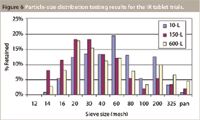
Figure 6
CR scale-up study. Bulk- and tap-density measurements of the CR granulations showed good similarity from laboratory to pilot to manufacturing scale (Table 5). Crushing-strength results reflected good tablet quality for all three scales, with the pilot-scale trials showing the highest values. All friability results were <0.35% weight loss, 6 min testing. PSD tests showed good correlation between the three scales (Figure 8). Dissolution curves were similar for tablets from all three scales (Figure 9).
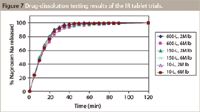
Figure 7
Comparison of batch versus continuous foam addition. Table 5 shows the granule- and tablet-property test results comparing batch and continuous addition. Figure 10 shows the PSD tests results and Figure 11 shows results of the drug-dissolution tests of prepared tablets. Results show a high degree of similarity between the two foam-addition techniques at the manufacturing scale.
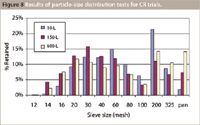
Figure 8
Results also reflect the processing flexibility and the high level of robustness inherent in the foam technology. For example, during the batch-process trial, the foamed liquid was in contact with the static powders in the 600-L granulator for just a little more than 9 min during the initial 19.3-L addition and for approximately the same length of time during the second 19-L addition of foamed liquid-binder solution. Yet the foamed process was forgiving to the point where no observable overwetting of the powders was detected. In addition, the powders appeared evenly coloured and wetted after each 5-min wet-massing stage and proceeded through the wet-milling step quite easily. This result is significant because even though the foam (liquid) contact time with the powders was long, the foam did not oversaturate the powders. The authors believe that, based on their prior experience in wet granulation, conventional spray wet-granulation technology would have great difficulty performing in a similar batch process for the wet-granulating of matrix CR tablet formulations. In addition, the successful batch-process trial, which used a 30 wt.% level of a hydrophilic, high molecular-weight cellulose ether polymer (Methocel K4M Premium, USP 2208) provides evidence that foam technology is a forgiving process in wet-granulation manufacturing of CR formulations.

Figure 9
Conclusion
Results from the scale-up trials using the continuous addition of foamed binder showed that the foam-granulation technology scaled easily with similar granule and tablet characteristics between scales. The results of the trials comparing continuous addition of foam with batch addition of foam at the manufacturing scale showed the process flexibility inherent in foam-granulation technology. The implication of foam-granulation technology in the pharmaceutical industry is that formulations will be easier to scale up as a result of fewer scaling issues such as nozzle placement, number of nozzles required and, potentially, rate of binder addition.

Figure 10
Acknowledgment
The authors would like to acknowledge the Perrigo Company in Allegan (MI, USA) for providing permission to conduct the pilot-scale and manufacturing-scale trials in its GMP pharmaceutical facility. The authors also would like to acknowledge Jim McGinnis, Perrigo R&D technologist, for his invaluable assistance in co-ordinating the scale-up trials within the Perrigo Company, and Jack Irwin, associate director at Perrigo R&D.

Figure 11
Paul Sheskey is a development leader at the Dow Chemical Company (USA). Colin Keary is a research associate, Dan Clark is a contract technologist, Karen Balwinski is a senior laboratory technologist.
References
1. "Niro Pharma Systems — History," http://www.collette.be.
2. Various papers presented at Advances in Wet Granulation Technology for Solid Oral Dosage Forms, AAPS Pharmaceutical Technologies Summer Conference, Lansdowne, VA, USA, 8–13 June 2003.
3. M. Bardin, P.C. Knigh and J.P.K. Seville, Powder Technol., 140, 169–175 (2004).
4. C.M. Keary and P.J. Sheskey, Drug Dev. Ind. Pharm., 30(8), 831–845 (2004).
5. T. Hlinak, Am. Pharm. Rev., 3(4), 33–36 (2000).
6. M. Yasumura and K. Ashihara, Pharm. Technol. Japan, 12(9), 1279–1289 (1996).
7. E. Russo, Pharm. Technol., 8(11), 46–56 (1984).
8. K. Ashihara and M. Yasumura, Kagaku Kogaku, 60(3), 180–182 (1996).
9. P. Sheskey, C. Keary and D. Clark, poster presented at the 2006 Annual Meeting and Exposition of the American Association of Pharmaceutical Scientists (San Antonio, TX, USA) 29 October–2 November 2006.
10. H. Leuenberger, Eur. J. Pharm. Biopharm., 52, 279–288 (2001).

PacBio Chosen as Tech Partner for Global Alzheimer’s Disease Research Project
April 23rd 2025The project, the North African Dementia Registry, will unite multiple entities for the purpose of developing a comprehensive dataset to advance the research community’s understanding of Alzheimer’s disease and other dementias in diverse populations.
Drug Solutions Podcast: A Closer Look at mRNA in Oncology and Vaccines
April 30th 2024In this episode fo the Drug Solutions Podcast, etherna’s vice-president of Technology and Innovation, Stefaan De Koker, discusses the merits and challenges of using mRNA as the foundation for therapeutics in oncology as well as for vaccines.